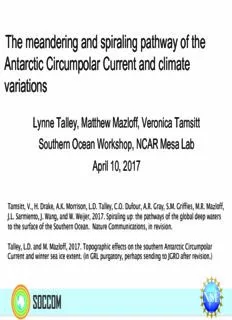
The meandering and spiraling pathway of the Antarctic Circumpolar Current and climate variations PDF
Preview The meandering and spiraling pathway of the Antarctic Circumpolar Current and climate variations
The meandering and spiraling pathway of the Antarctic Circumpolar Current and climate variations Lynne Talley, Matthew Mazloff, Veronica Tamsitt Southern Ocean Workshop, NCAR Mesa Lab April 10, 2017 Tamsitt, V., H. Drake, A.K. Morrison, L.D. Talley, C.O. Dufour, A.R. Gray, S.M. Griffies, M.R. Mazloff, J.L. Sarmiento, J. Wang, and W. Weijer, 2017. Spiraling up: the pathways of the global deep waters to the surface of the Southern Ocean. Nature Communications, in revision. Talley, L.D. and M. Mazloff, 2017. Topographic effects on the southern Antarctic Circumpolar Current and winter sea ice extent. (in GRL purgatory, perhaps sending to JGRO after revision.) Take-home § ACC has standing meanders § These affect interaction with the cryosphere § One large one: inward and upward spiral (set by S. America and Ant. Peninsula) § Affects where warm water reaches shelves and hence ice shelves § Standing meanders on scale of basins (set by topographic obstructions and ridges) § Affects ACC southern front location and maximum winter sea ice § Causes poleward heat transport in ocean (does this affect the atmosphere?? Amundsen Sea Low?) § Wind stress curl forcing + topography is essential for understanding how circulation and ice changes Questions » Why do Antarctic ice shelf decline and sea ice growth/decline have their peculiar nonzonal spatial patterns? » Why does Antarctic winter sea ice have its peculiar pentagonal spatial pattern? » Why does the southern side of the ACC (the sea ice edge) have the shape that it does? (topography -> standing meanders) » Can we partially explain the standing meander pattern of the ACC using linear vorticity balance? » What circulation changes are observed, how are these related to wind, and how does these affect ice? Outline § Ice season duration trend pattern § Winter sea ice pattern and southern ACC fronts § Pattern of spiral circulation, standing meanders of the ACC southern fronts and the linear vorticity balance with wind stress curl, beta, and topography § Hydrographic property changes and likely relationship to strengthening winds and wind stress curl The Southern Ocean overturning: first step towards 3-D with differences between ocean basins. Now it’s time to get much more specific about the 3-D flows! (new schematic on its way? Group work this week?) Deep water inflow Deep waters rise to sea surface in and south of ACC Formation of AABW and thermocline waters Talley (Oceanography, 2013) After Schmitz who was After Gordon A look at the ACC’s standing meander pattern and the spatial structure of: shelf temperature and ice shelf melt sea ice sea ice duration trend Ice sheet mass loss and proximity to warm ocean water Potential temperature at γN = 28.05 (NADW - LCDW isopycnal) Orsi and Whitworth (WHP atlas, 2005) Paolo et al. (2015) • Inward (and upward) spiral of warm North Atlantic Deep Water (Tamsitt talk) • Topographic constraints on cold-warm boundaries, especially at Ross and Weddell Gyres, which extend MUCH farther north than they should based on where continental boundaries lie • -> Ridges are acting as boundaries (equivalent BT flow) Antarctic winter (September) sea ice Antarctic sea ice trend: spatial structure Trend in sea ice duration: Trend in sea ice 1979–2006 duration:1979-2010 Stammerjohn et al. (2008) Antarctic sea ice trend: spatial structure Trend in sea ice concentration: Trend in sea ice 1979 – 2016 duration:1979-2010
Description: